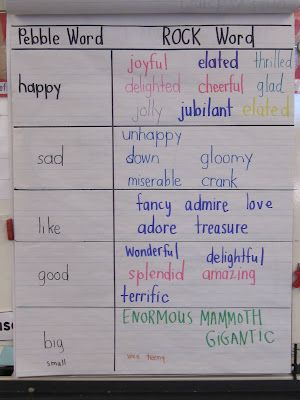Goal:
Students will understand the importance of using language to express an idea clearly and to be able to replace a basic word with a better choice that is even more descriptive.
Specific Learning Objectives:
- Students will learn how to use words from the story.
- Students will learn how to recognize the importance of word choice to create a better story.
- Students will be able to describe how some words can be replaced with even better words to make a story more interesting.
- Students will learn how to match words and pictures that match to create a better story.
- Students will be able to transfer what they learn and discuss better word usage in their writing, especially in opinion writing.
Introduction/ Hook:
Before the lesson, read the story, When Sophie Gets Angry. Discuss the details of how the author uses language and certain word choices to paint a picture. Brainstorm words with similar meanings that the author could have used to say the same thing and write them on a dry-erase board. Use a graphic organizer to highlight the levels of frustration that Sophie goes through in the story and then take those words to make pictures that express the same emotions. Discuss feelings associated with a time your child felt angry.
Day 1
After modeling the story fill out a chart of different emotions. Allow your child to choose words that go with particular pictures. Once they have their words and filled out their graphic organizers, they will write one sentence that uses the word they chose. After completing their sentence, they will share it with you and the sentence you wrote then replace the emotion word for one of their choice. At the end, share your word choices and discuss how words affect the sound of our writing. It is a really good practice to encourage your child to update a wonderful word journal with each writing assignment. Creating a wonderful word journal expands vocabulary and stresses the importance of utilizing various word choices.
Day 2
On the second day, review word choices again. Write the story of When Sophie Gets Angry using sentences that were made the day before. Model taking your sentence and using your word. Discuss and model how the author used colors to strengthen the choice of words that describe emotions. Have your child assist in creating a picture that matches your word choice, paying particular attention to the colors you used. The visual part of this lesson of using colors and pictures to highlight what you chose for a word will strengthen the connection to word choices.
Follow-up Lesson
(Idea taken from Pinterest) Make an anchor chart with a pebble (basic) word on the left side and rock words (more descriptive)

Assessment
Student’s body of work from our writing for word choice. Evidence in writing samples.
